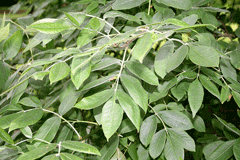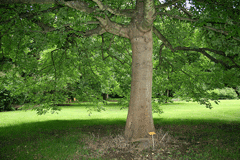 |
|
http://commons.wikimedia.org/wiki/User:Jean-Pol_GRANDMONT |
 |
| http://commons.wikimedia.org/wiki/User:Jean-Pol_GRANDMONT |
Translate this page:
Summary
Physical Characteristics

 Fraxinus_latifolia is a deciduous Tree growing to 20 m (65ft 7in).
Fraxinus_latifolia is a deciduous Tree growing to 20 m (65ft 7in).
See above for USDA hardiness. It is hardy to UK zone 6. It is in flower in April, and the seeds ripen in October. The species is dioecious (individual flowers are either male or female, but only one sex is to be found on any one plant so both male and female plants must be grown if seed is required). and is pollinated by Wind. The plant is not self-fertile.
Suitable for: light (sandy), medium (loamy) and heavy (clay) soils. Suitable pH: mildly acid, neutral and basic (mildly alkaline) soils. It cannot grow in the shade. It prefers moist soil. The plant can tolerate maritime exposure.
It can tolerate atmospheric pollution.
UK Hardiness Map
US Hardiness Map
Synonyms
F. oregona.
Plant Habitats
Edible Uses
References More on Edible Uses
Medicinal Uses
Plants For A Future can not take any responsibility for any adverse effects from the use of plants. Always seek advice from a professional before using a plant medicinally.
The pulverised fresh roots were used by some native North American Indian tribes to treat serious wounds[213, 257]. A cold infusion of the twigs has been used to treat fevers[257]. The bark is anthelmintic[257].
References More on Medicinal Uses
The Bookshop: Edible Plant Books
Our Latest books on Perennial Plants For Food Forests and Permaculture Gardens in paperback or digital formats.

Edible Tropical Plants
Food Forest Plants for Hotter Conditions: 250+ Plants For Tropical Food Forests & Permaculture Gardens.
More

Edible Temperate Plants
Plants for Your Food Forest: 500 Plants for Temperate Food Forests & Permaculture Gardens.
More

More Books
PFAF have eight books available in paperback and digital formats. Browse the shop for more information.
Shop Now
Other Uses
A fairly wind resistant tree, it can be grown as part of a shelterbelt planting[200]. Wood - hard, brittle, light, coarse grained. A valuable timber tree, it is largely used for making furniture, the interiors of buildings, cooperage etc, and as a fuel[46, 61, 82, 171].
Special Uses
References More on Other Uses
Cultivation details
Prefers a deep loamy soil, even if it is on the heavy side[1, 200]. Most members of this genus are gross feeders and require a rich soil[11, 200]. Plants succeed when growing in exposed positions[200] and also in alkaline soils[11]. They tolerate atmospheric pollution[200]. A fast growing tree for its first 75 years in the wild, it then grows slowly reaching a maximum age of 250 years[229]. This species is closely related to F. pennsylvanica[200]. Dioecious. Male and female plants must be grown if seed is required.
References Carbon Farming Information and Carbon Sequestration Information
Temperature Converter
Type a value in the Celsius field to convert the value to Fahrenheit:
Fahrenheit:
The PFAF Bookshop
Plants For A Future have a number of books available in paperback and digital form. Book titles include Edible Plants, Edible Perennials, Edible Trees,Edible Shrubs, Woodland Gardening, and Temperate Food Forest Plants. Our new book is Food Forest Plants For Hotter Conditions (Tropical and Sub-Tropical).
Shop Now
Plant Propagation
The seed is best harvested green - as soon as it is fully developed but before it has fully dried on the tree - and can then be sown immediately in a cold frame[80]. It usually germinates in the spring[80]. Stored seed requires a period of cold stratification and is best sown as soon as possible in a cold frame[200]. Prick out the seedlings into individual pots when they are large enough to handle and grow them on in a cold frame for their first winter. Plant them out into their permanent positions or a nursery bed in late spring or early summer of the following year. If you have sufficient seed then it is possible to sow it directly into an outdoor seedbed, preferably in the autumn. Grow the seedlings on in the seedbed for 2 years before transplanting either to their permanent positions or to nursery beds.
Other Names
If available other names are mentioned here
Native Range
Coming Soon NORTHERN AMERICA: United States (Oregon (west), Washington (west), California (north & central))
Weed Potential
Right plant wrong place. We are currently updating this section.
Please note that a plant may be invasive in one area but may not in your area so it’s worth checking.
Conservation Status
IUCN Red List of Threatened Plants Status :

Growth: S = slow M = medium F = fast. Soil: L = light (sandy) M = medium H = heavy (clay). pH: A = acid N = neutral B = basic (alkaline). Shade: F = full shade S = semi-shade N = no shade. Moisture: D = dry M = Moist We = wet Wa = water.
Expert comment
Author
Benth.
Botanical References
1160200
Links / References
For a list of references used on this page please go here
Readers comment
| Add a comment |
|
If you have important information about this plant that may help other users please add a comment or link below. Only comments or links that are felt to be directly relevant to a plant will be included. If you think a comment/link or information contained on this page is inaccurate or misleading we would welcome your feedback at [email protected]. If you have questions about a plant please use the Forum on this website as we do not have the resources to answer questions ourselves.
* Please note: the comments by website users are not necessarily those held by PFAF and may give misleading or inaccurate information.
To leave a comment please Register or login here All comments need to be approved so will not appear immediately.
|
Subject : Fraxinus_latifolia
|
|
|
|